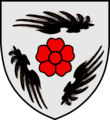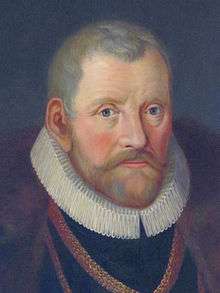Valkendorf
Valkendorf (Denmark) or Walkendorff (Sweden) is a Danish and Swedish medieval noble family, which can be traced back to the 14th century with the arrival in Denmark of knight Heinrich (Henning) Valkendorf. The most prominent member of the Danish family was Christoffer Valkendorf, who served as Steward of the Realm during the early reigh of Christian IV. Members of the family were major landowners on the island of Funen where they owned Glorup Manor for almost rwo hundred wears. The Danish branch was extinct in 1747.
| Valkendorff / Walkendorff | |
|---|---|
| Noble family | |
 | |
| Country | |
| Founded | 14th century (Denmark 17th century (Sweden)) |
| Founder | Henning von Walkendorff |
Denmark
It is likely that the Walkendorff family originates from Mecklenburg-Vorpommern, where remnants of a castle has been found in the small village of Walkendorf.[1] Henning Valkendorf is first mentioned in Denmark in 1374. His son, Peder Valkendorf (mentioned 1378 and 1405)m a knight, was the grand father of Councillor of the Realm Hans Valkendorf (mentioned 1468 and 1498) and district judge Axel Valkendorf (died 1483). Axel Valkendorf acquired Glorup Manor on Funen in 1479 and members of the family owned the estate until 1659. Notable members of the family include the statesman Christoffer Valkendorff. Members of the family have also owned the estates Søbogaard, Brandstrup and Tiselholt.
The Danish Valkendorf branch died out in 1747 with the passing of Major Børge Walkendorff.[2]
Swedish branch
The Swedish Walkendorff branch was introduced at the Swedish House of Nobility as Nr 25 in 1664 through Christopher Walkendorff (1621-1690) after the cession of the Danish province Scania (Skåne) to Sweden.
Notable members
Denmark

- Christoffer Valkendorff (1525-1591), statesman
- Knud Valkendorf (died 1527), rector of University of Copenhagen
- Erik Valkendorf (died 1522), bishop
- Erik Valkendorf (c. 1523 - 1605), landowner
- Jørgen Henning Valkendorf (1661–1724), district governor of Rugård Amt
See also
- List of Swedish noble families
- Ellinge Castle - Christoffer Walkendorff was Ellinge's Manager from 1640-1690
References
- Elgenstierna, Gustaf (1934). Den introducerade Svenska adelns ättartavlor: med tillägg och rättelser. Stålarm - Voltemat, Volume 8. Stockholm: PA Norstedt & Söners Förlag. p. 651.
- Danmarks Adels Aarbog. Odense: Syddansk Universitetsforlag. 2009. p. 441.